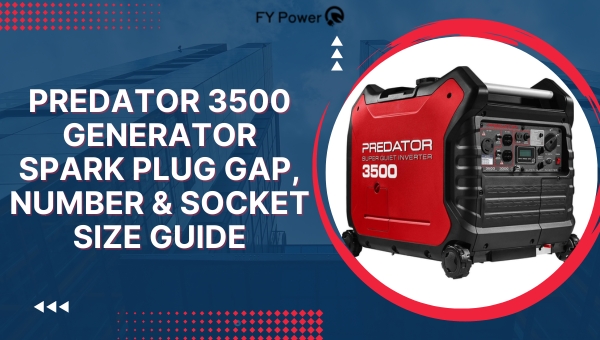Just like a key fits perfectly into its lock, your Predator 3500 generator requires an exact spark plug gap and socket size to function at its best. This guide will be your locksmith, providing precise, technical information on selecting the Predator 3500 Generator spark plug, measuring the correct gap, and ensuring proper installation.
If your spark plug is incorrectly gapped or sized, your generator could face serious issues. But don’t fret, we’ve got your back. We’ll also delve into when it’s time to replace your old spark plugs and the benefits of doing so regularly on your Predator 3500 engine.
By the end of this journey, you’ll not just own a Predator 3500, you’ll belong to the community of well-informed users who understand the heart of their machines. So, tighten your grip and get ready to unlock the potential of your Predator 3500 generator.

Key Takeaways
- Recommended spark plug gap for Predator 3500 generator: 0.027″– 0.031″ (0.7-0.8 mm)
- Spark plug socket size required: 13/16″ (21mm)
- Use spark plug gap gauge for accurate measurement and adjust as needed
- Consider upgrading to NGK Iridium Spark Plug (BPR6EIX) for improved performance and lifespan.
Predator 3500 Generator Spark Plug Gap and Socket Size
Here’s an in-depth guide detailing the spark plug gap and socket size for your Predator 3500 generator.
Your generator’s spark plug type is either F7RTC (Torch) or an equivalent. If you’re looking to upgrade, the BPR6EIX – NGK Iridium Spark Plug is a great option.
The crucial gap for your spark plug is between 0.027″– 0.031″ (0.7-0.8 mm). This precise gap ensures optimal generator performance.
As for the socket size, it is 13/16″ (21mm), perfect for accommodating the spark plug.
Related Post: Honda GX620 Spark Plug Gap, Number, and Socket Size Guide
How to Measure the Correct Spark Plug Gap for a Predator 3500 Engine?
Measuring this critical distance with accuracy demands precision, and I’m going to walk you through the steps to ensure you get it just right.
First, you’ll need a spark plug gap gauge. This handy tool helps you measure the gap between your spark plug’s center and the ground electrode.
Insert the gauge into the gap and read the measurement. If it’s not between 0.027′ and 0.031′ (0.7-0.8mm), adjust it.
To increase the gap, gently pry the ground electrode away from the center electrode. To decrease it, press the ground electrode closer.
Always remember accuracy is key in this process.
Tips on Ensuring Proper Installation of the New Spark Plugs in a Predator 3500 Engine
Let’s dive into some handy tips that’ll help you nail the installation of your new engine component without a hitch. When installing new spark plugs in your Predator 3500 engine, there are some important guidelines to follow:
- Always use a spark plug socket to remove and install spark plugs. This helps protect the delicate ceramic insulator from damage.
- Make sure the spark plug gap is correctly set. Check the engine manual for specifications.
- Never over-tighten spark plugs. This can damage the threads in the engine head.
- Apply a small amount of anti-seize compound to the plug threads before installation.
- Finally, always re-install the spark plug wire boot until it clicks into place.
By following these tips, you are ensuring a smoother, more efficient engine operation. But what happens when things go south? Let’s take a look at potential problems when spark plugs are gapped or sized incorrectly.
Related Post: Guide To Honda GC160 Spark Plug Gap, Number & Socket Size
Common Issues with Incorrectly Gapped and Sized Sparks Plugs in a Predator 3500 Engine
When you don’t get right with the configuration of your engine components, you’re bound to face a few hiccups. Incorrectly gapped spark plugs can cause a whole host of problems for your Predator 3500 generator.
Too wide a gap can lead to a weak spark, poor combustion, and reduced power output. Conversely, if the gap is too narrow, the spark might not occur at all, causing your generator to run rough or not start.
Using the wrong spark plug number or socket size might also result in improper fit and sealing, leading to oil leaks and potential engine damage.
These problems can be quite a nuisance, but with regular maintenance and appropriate replacements, you’re on the road to better engine health and performance. Let’s delve into the benefits of regular spark plug replacements next.
Benefits of Regularly Replacing Your Spark Plugs on your Predator 3500 Engine
Regular maintenance of your 3500 engine, including changing out those vital components, can significantly boost its performance and longevity. By regularly replacing your spark plugs, you ensure optimal fuel efficiency and smoother engine operation.
You’ll also notice a decrease in emissions, contributing to a cleaner environment. Importantly, it also reduces the risk of serious engine damage. We’re all part of the Predator 3500 community, and it’s this shared responsibility to keep our engines running smoothly that bonds us together.
Regular maintenance, like spark plug replacement, is an integral part of that. By maintaining your engine, you not only reap personal benefits but contribute to the overall health of our collective group of Predator 3500 enthusiasts.
Let’s now delve into the signs that indicate when those old spark plugs need a swift change-out.
Related Post: Guide To Honda Eu2200i Spark Plug Gap, Number & Socket Size
When to Replace Your Old Sparks Plugs with new ones?
Understanding the importance of maintaining your Predator 3500 generator is one thing, but knowing when to actually replace the spark plugs is another. It’s crucial to recognize the signs that your spark plugs need changing. Here’s a brief guide to help you:
- Decreased performance: If your generator fails to start properly or runs roughly, old spark plugs could be the issue.
- Increased fuel consumption: Worn spark plugs can decrease your generator’s fuel efficiency.
- Persistent engine problems: Issues like engine misfires or surging could be due to faulty spark plugs.
- Over 100 hours of operation: As a rule of thumb, replace your spark plugs every 100 hours of use to maintain optimal performance.
Remember, your Predator 3500’s lifespan is in your hands, so stay on top of maintenance.
Frequently Asked Questions
What is the average lifespan of a spark plug in a Predator 3500 Generator?
On average, the spark plug in your Predator 3500 generator can last around 500 hours of use. However, it’s best to check it every 100 hours to ensure optimal performance and prolong its lifespan.
Can the wrong spark plug damage the Predator 3500 engine?
Absolutely, using the wrong spark plug can damage your Predator 3500 engine. Misfit spark plugs can cause overheating, pre-ignition, or even cylinder head damage. Always ensure you’re using the correct spark plug for optimal performance.
Is there a specific brand of spark plug that works best with the Predator 3500 Generator?
Just like a conductor choosing the perfect orchestra, you’ll want the right spark plug for your Predator 3500 generator. NGK’s spark plugs have proven to be a harmonious fit, delivering reliable and efficient performance.
How does a Predator 3500 Generator perform with incorrectly installed spark plugs?
If you install spark plugs incorrectly in your Predator 3500 generator, it may run inefficiently, misfire, or not start at all. Proper installation ensures optimal performance and longevity, so always double-check your work.
What are the signs of a malfunctioning spark plug in a Predator 3500 Generator?
You might notice trouble starting your generator or erratic performance. Perhaps there’s increased fuel consumption or even engine misfires. These could all be signs of a malfunctioning spark plug in your Predator 3500 generator.
Conclusion
Maintaining the right spark plug gap and size in your Predator 3500 engine ensures optimal performance and longevity. If you neglect this, you may encounter frequent engine issues. Regular spark plug replacement also boosts your engine’s efficiency.
Remember, it’s not just a theory, it’s a practical truth that proper spark plug maintenance is key to your generator’s health. So, stay informed and keep your generator running smoothly.

